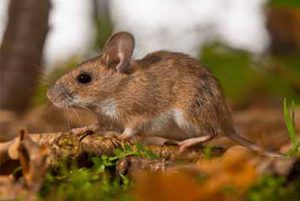Deer mice prefer rural, outdoor areas. They are rarely a problem in urban or residential areas, but can be a common pest in farming areas, summer/vacation homes, outbuildings, sheds and suburban homes near wooded areas.
Deer Mice Identification
Color
Brown with light feet and underbelly
Shape & Structure
Round
Size
2¾ to 4 inches long
Characteristics
Deer mice often nest in old fence posts, tree hollows, log piles, abandoned bird nests and beneath decks. During winter months, they may invade homes, garages, sheds or rarely used vehicles to seek shelter. Inside, they can make their nest in storage boxes, stuffed furniture, drawers, wall voids and tight areas in basements or attics.
Habitat & Behavior
Deer mice feed at dusk and dawn, preferring insects, seeds, nuts, berries and small fruits. They are a medical concern because they are the common carrier of Hantavirus. This virus is transmitted primarily by the inhalation of dust particles contaminated with the urine, feces or saliva of infected deer mice.
Prevention & Treatment
Seal cracks and holes on the outside of your home to prevent mice from using easy entryways. Pay special attention to areas where utilities and pipes enter the home. Replace loose mortar and weather stripping around the basement foundation and windows. Keep shrubs and tree branches cut back from the house. Mice can hide in clutter, so keep areas clear, and store boxes off of the floor. Don’t store pet food or bird seed in garages or storage sheds, where it is especially attractive to deer mice. Regularly inspect basements, attics, outbuildings and rarely used cars/RVs for signs of an infestation. If you suspect an infestation, contact a licensed pest professional.



